Fluffy, long-haired breeds often steal the spotlight, but there’s an equally captivating world of cats boasting a strikingly different appearance: hairless cats. Among these unique felines, the Sphynx cat stands out as perhaps the most iconic and recognizable. While their lack of fur might initially raise eyebrows, these breeds, particularly the Sphynx, have garnered a devoted following for their distinctive looks and affectionate personalities. But don’t let the “hairless” label fool you – caring for a Sphynx cat or any hairless breed requires a dedicated approach to grooming, temperature regulation, and overall well-being.
The Allure of Hairless Cats: Beyond the Fur
The immediate visual impact of a hairless cat is undeniable. Their wrinkled skin and large ears create an exotic and almost otherworldly appearance that draws attention and sparks curiosity. However, the appeal of these breeds goes far beyond mere novelty. Many owners are drawn to their velvety soft skin, which, contrary to popular belief, isn’t entirely bare. Breeds like the Sphynx are often covered in a fine down, resembling the texture of suede or chamois. This unique tactile experience makes them incredibly pleasant to touch and cuddle, offering a warmth that can be especially comforting.
It’s a common misconception that hairless cats are low-maintenance pets due to their lack of fur. In reality, they require a different kind of care, perhaps even more attentive in some aspects than their furry counterparts. Their exposed skin is more vulnerable to the elements, necessitating protection from both sun and cold. Regular grooming is also essential, not to combat shedding, but to manage skin oils and maintain hygiene. Despite these specific needs, the devoted fans of Sphynx cats and other hairless breeds will attest that the extra effort is wholeheartedly worthwhile, rewarded by their unique charm, affectionate nature, and the strong bond they form with their human companions.
Exploring Hairless Cat Breeds: Meet the Family
While the Sphynx might be the most famous face in the hairless cat world, it’s just one member of a fascinating family. Each breed brings its own unique history and characteristics to the table, offering a diverse range of personalities and appearances within the hairless category.
The Sphynx: The Original Hairless Wonder
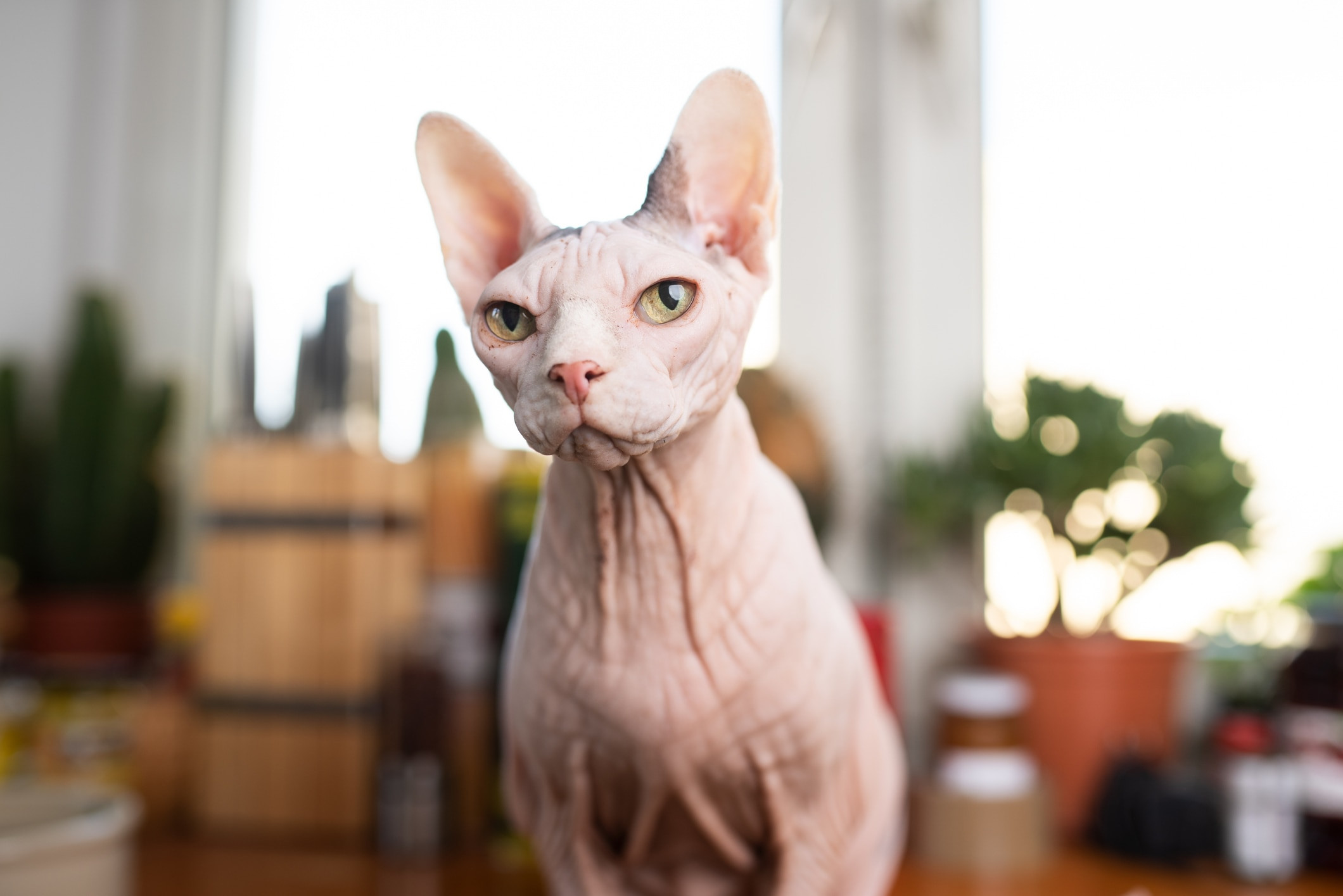 pink sphynx cat looking down at the camera in a living room
pink sphynx cat looking down at the camera in a living room
Photo credit: Nils Jacobi/iStock / Getty Images Plus via Getty Images
The Sphynx cat, often considered the quintessential hairless breed, is far from truly bald. Instead, they are covered in a soft, downy fuzz that gives them a suede-like feel. As April Arguin, breeder and founder of LiLNudists Cattery, aptly describes, their skin resembles chamois, making them wonderfully warm and cuddly, especially on cooler mornings. Sphynx cats are characterized by their striking wrinkles, prominent cheekbones, and large, expressive eyes. Some possess whiskers and eyebrows, while others have a completely smooth face, adding to their individual charm. Their bodies are muscular and surprisingly heavy, and they often have noticeably long toes. Beyond their physical attributes, Sphynx cats are known for being highly vocal and communicative, expressing themselves with a variety of meows and purrs. If you’re looking for a cat that will actively engage with you and “talk back,” the Sphynx might be your perfect match.
Beyond the Sphynx: Other Hairless Breeds
While the Sphynx set the stage, several other hairless breeds have emerged, each with its own distinct story and traits.
Bambino
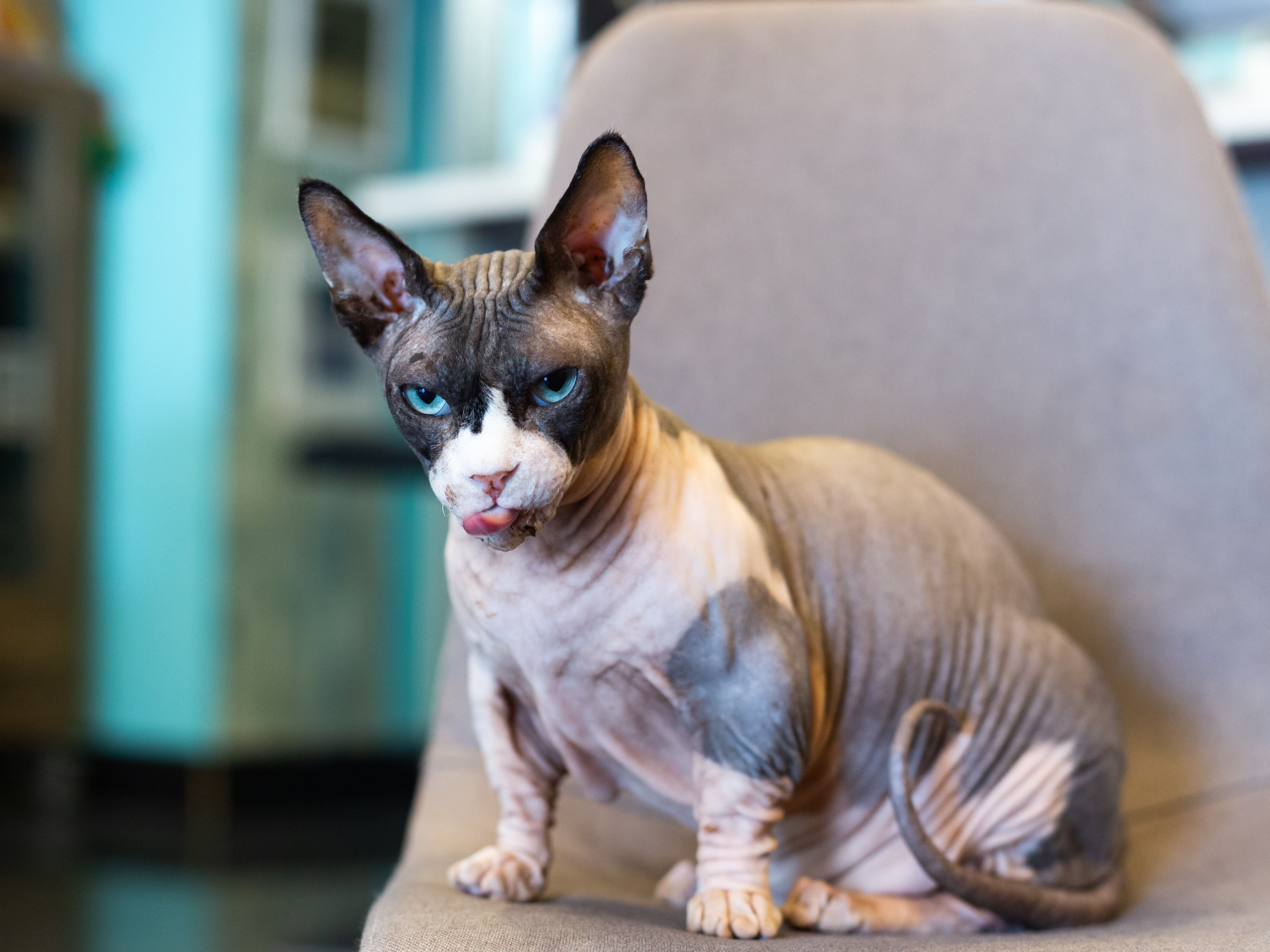 pink and gray bambino cat licking his lips
pink and gray bambino cat licking his lips
Photo credit: Adobe Stock/Anne Richard
A relatively recent addition to the hairless cat scene, the Bambino breed was established in 2005. Currently considered an “experimental breed” by the Cat Fanciers Association, the Bambino is a captivating cross between the Sphynx and the short-legged Munchkin. This unique combination results in a hairless cat with the Sphynx’s signature lack of fur and the Munchkin’s adorably short legs. Bambinos are known for their affectionate and people-oriented nature. As Arguin notes, they thrive on interaction and attention from their human families. Bringing a Bambino into your home means committing to providing plenty of daily playtime and interaction to keep them happy and stimulated. It’s worth noting that their unique genetics come with a higher price tag, and they may be prone to joint issues due to their short legs.
Peterbald
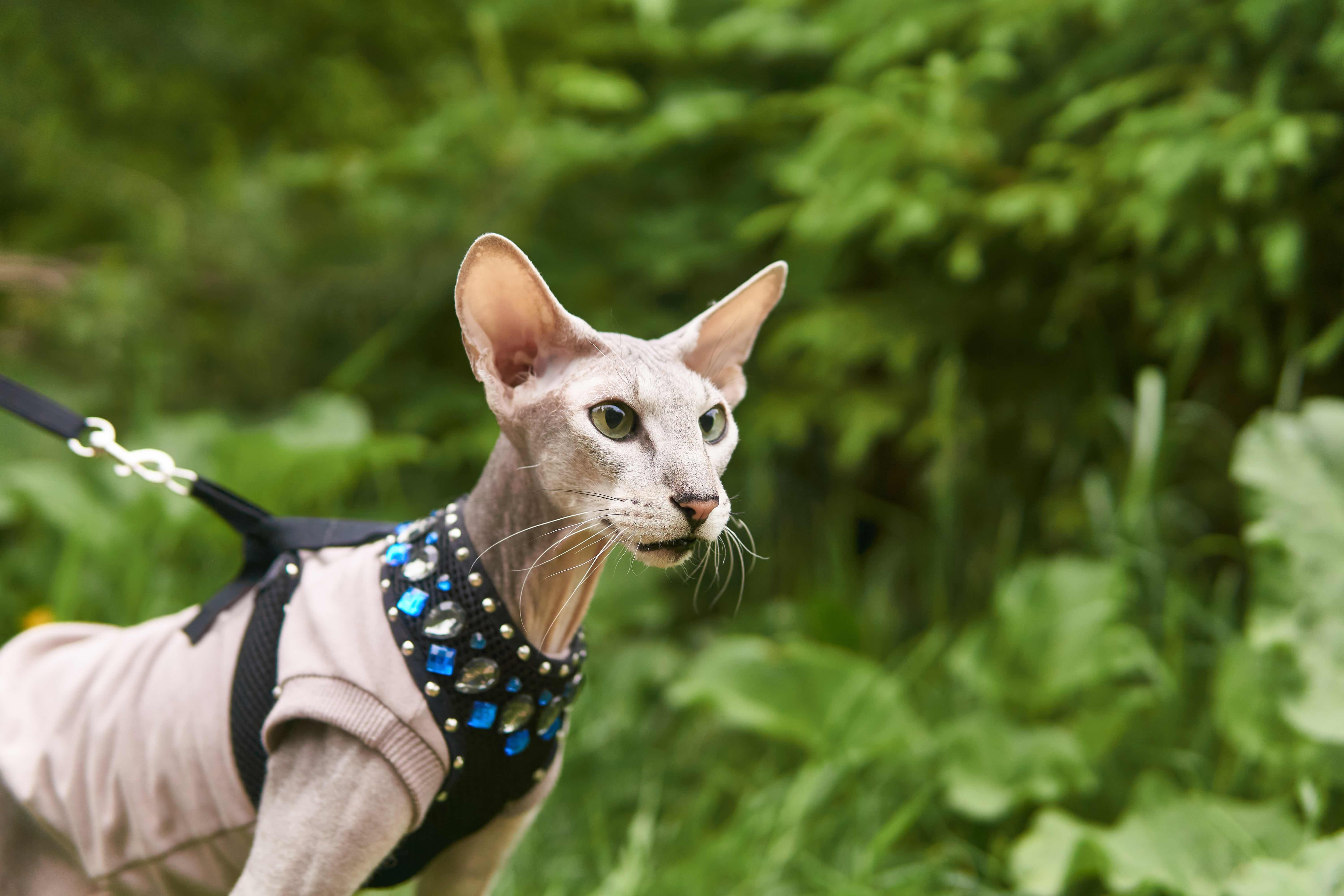 gray peterbald cat wearing a sweater on a leash
gray peterbald cat wearing a sweater on a leash
Photo credit: Adobe Stock/Evgeny
Originating from Russia, the Peterbald is another fascinating hairless breed distinguished by its large, pointed ears that seem disproportionately large for its wedge-shaped head. Peterbalds are less common outside of Russia, but they are gaining popularity for their energetic and friendly personalities. They are known to be playful and interactive, often enjoying games of fetch and following their owners around the house. Interestingly, not all Peterbalds are completely hairless. The breed exhibits a range of coat variations, from completely bare to fuzzy, curly, or even wiry fur of varying lengths. Some Peterbalds can even develop a short or long coat similar to typical domestic cats, showcasing the diversity within this breed.
Donskoy
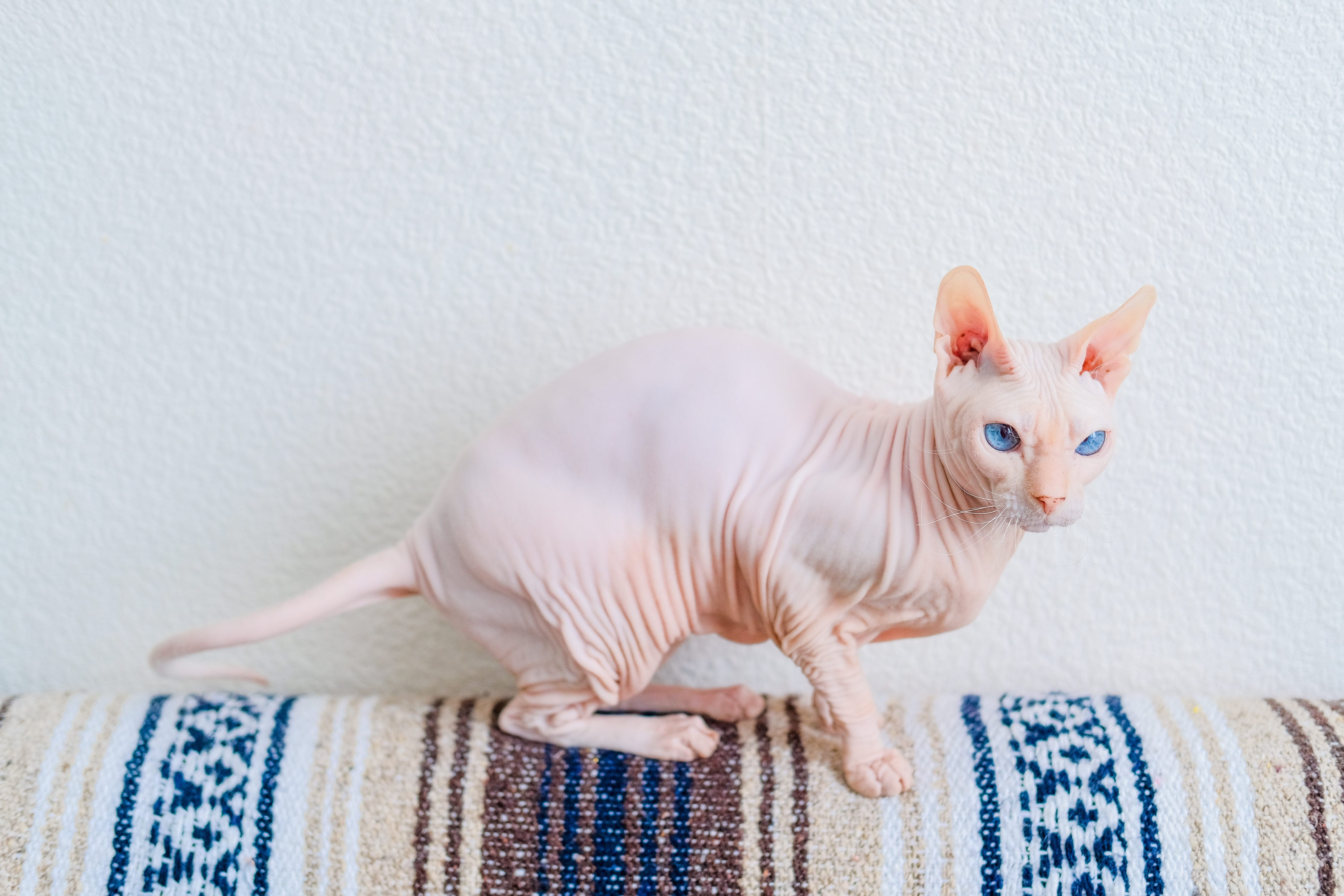 pink hairless cat with blue eyes perched on the back of a couch
pink hairless cat with blue eyes perched on the back of a couch
Photo credit: Adobe Stock/yolya_ilyasova
Another Russian breed, the Donskoy, also presents a variety of hairlessness levels, categorized into four types: Rubber bald (born bald and remain so), Flocked (downy fuzz, may lose fuzz), Velour (bald spot on head), and Brush (sparse, wiry coat with bald patches). Despite these variations, Donskoy cats are consistently praised for their sweet and intelligent personalities. They are known to be friendly and adaptable, making them excellent family pets, even in households with children and other animals. Their gentle nature and playful demeanor make them engaging companions for people of all ages.
Lykoi
 gray lykoi cat lying on his side and looking at the camera
gray lykoi cat lying on his side and looking at the camera
Photo credit: Angela Emanuelsson/iStock / Getty Images Plus via Getty Images
Nicknamed the “werewolf cat,” the Lykoi is a more recently recognized breed with a uniquely sparse coat. Lykois are known for “wolfing out,” a phenomenon where they molt a significant portion of their already thin fur periodically. When they do have fur, it’s incredibly soft, adding to their cuddly appeal. This breed’s distinctive appearance and gentle nature have contributed to its growing popularity, though owning a Lykoi kitten comes with a higher price tag due to their rarity and unique genetic traits.
Ukrainian Levkoy
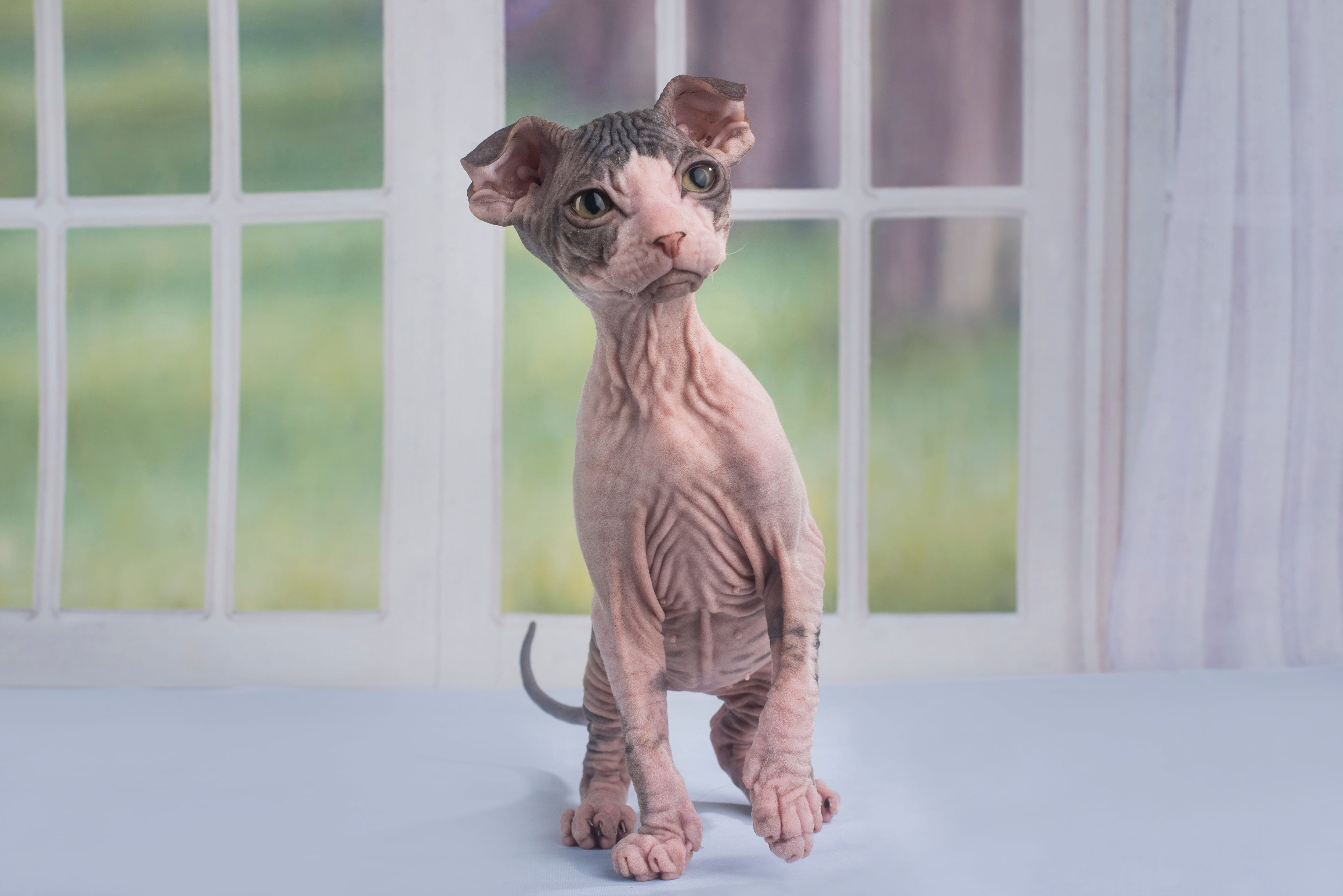 hairless ukrainian levkoy kitten standing in front of a window backdrop
hairless ukrainian levkoy kitten standing in front of a window backdrop
Photo credit: Adobe Stock/Светлана Валуйская
The Ukrainian Levkoy is another newer hairless breed, established in 2004, and notable for its folded ears, a trait it shares with its close relative, the Scottish Fold. Due to its recent development, the long-term health of the Ukrainian Levkoy is still being studied. However, the Scottish Fold’s predisposition to joint and cartilage problems suggests potential similar health risks for the Levkoy. While folded ears are a highly sought-after and often expensive trait, not all Ukrainian Levkoys inherit this gene. Regardless of ear type, they are typically described as stoic and independent cats who can enjoy companionship but are also content in their own quiet solitude.
Caring for Your Hairless Companion: Essential Tips
Welcoming a hairless cat, especially a Sphynx cat, into your family is a rewarding experience, but it’s crucial to understand their specific care needs. Their lack of fur means they are more vulnerable to environmental factors and require a proactive approach to their health and well-being.
One of the primary considerations is their sensitivity to temperature extremes. Without fur, hairless cats are more susceptible to sunburn in strong sunlight. Therefore, limiting their exposure to direct sun, using window UV filters, and even applying pet-safe sunscreen to exposed areas like ears and nose are important precautions. Conversely, they also feel the cold more intensely than furry cats. Providing warm environments, cozy sweaters during colder months, and heated bedding can help them maintain a comfortable body temperature.
Skin care is another vital aspect of hairless cat ownership. They tend to produce more skin oils than furry cats, which can lead to a greasy feel and potential skin issues if not managed. While frequent full baths can dry out their skin, regular wipe-downs with a damp cloth or specialized pet wipes can help keep their skin clean. Consulting with your veterinarian about a recommended skincare routine, including the use of special shampoos designed to replenish natural skin oils, is highly advisable.
Furthermore, their ears and nails require more frequent cleaning. Hairless cats tend to accumulate more wax and oil buildup in their ears, necessitating regular ear cleaning to prevent infections. Similarly, their nails may also need trimming more often.
Despite these specific care requirements, the love and companionship offered by a hairless cat, particularly the affectionate Sphynx, make them truly exceptional pets for those prepared to meet their unique needs.
Hairless Cat FAQs
Are Sphynx cats hypoallergenic?
While no cat is truly hypoallergenic, Sphynx cats are often considered among the best choices for people with allergies. The primary allergens in cats are found in their saliva, urine, and dander, not just their fur. However, because Sphynx cats have less dander, which is often carried by fur, they may trigger fewer allergic reactions in some individuals. It’s crucial to understand that allergies are complex, and reactions can vary. Before bringing any cat home, especially a hairless breed, it’s always recommended to consult with your doctor about allergy management strategies and ideally spend some time with the breed to assess your personal reaction.
How much are Sphynx cats?
Due to their unique appearance and popularity, Sphynx kittens can be more expensive than many other breeds. Expect to pay in the range of $1,000 to $2,000 or even more for a Sphynx kitten from a reputable breeder. Adopting a Sphynx from a shelter is less common, but it’s worth checking local shelters and specialized rescues that focus on purebred cats, as you might occasionally find a hairless cat in need of a home.
Are Sphynx cats friendly?
Yes, Sphynx cats are widely known for their friendly and affectionate personalities. Like all cats, their temperament is influenced by genetics and socialization, especially during kittenhood. Early and positive exposure to people, other pets, and various experiences helps them develop into well-adjusted and friendly companions. Sphynx cats are often described as being very people-oriented, enjoying cuddling, playing, and being involved in their families’ activities. With proper socialization and positive reinforcement, Sphynx cats can be incredibly loving and devoted members of the family.
WRITTEN BY
Janelle Leeson
Freelance Writer
